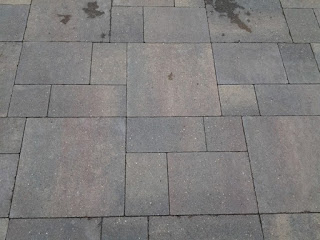 |
| The curved chalk line follows the vehicle tires into this driveway. Not only do the pavers creep in this example the bed sand is pushing outward from the loads. |
This picture illustrates Creep. While Creep can
happen on patios and walks it is much more common on driveway applications
where repetitive breaking or turning loads from vehicular traffic are present.
Inappropriate paver shape, thickness, aspect ratio and laying pattern will lead
to Creep. Improper choice or installation of an edge restraint system can
also contribute to Creep.
All to often creep begins with poor choices.
Interlocking Concrete Paver Institute (ICPI) suggests a 60 or 90 degree
Herringbone pattern for driveway applications. Not all people like the
"look" of this pattern and designers give way to that sentiment
allowing homeowners other choices. While short term the homeowner has received
what they wanted, long term it becomes a disaster.
There are multiple edge restraint systems and the ultimate
would be a poured in place concrete curb. Concrete curbs will not push outward
from vehicular turning loads. Flush concrete beams can also be poured with in
the body of an installation to help keep it in place preventing Creep.
Creep affects the structural integrity of an
application leading to loss of interlock and joint/bed sand washout. While
replacing a driveway using the correct paver and laying patterns may not be
feasible, The Paver Doctor has proven methods of repair. Feel free to call
regarding this or any other issues related to your pavers. We specialize
in paver Repair-Restoration-Sealing.




